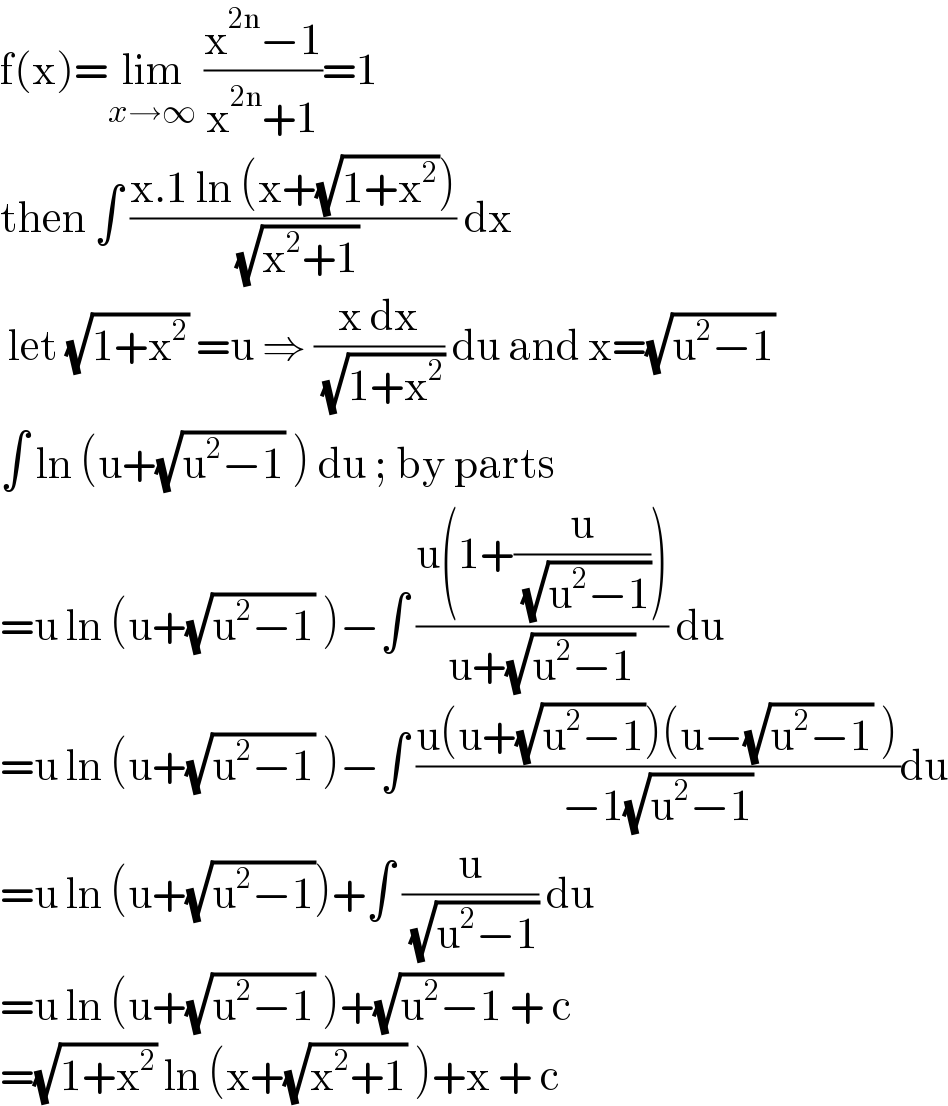
Question Number 128540 by bramlexs22 last updated on 08/Jan/21

$$\mathrm{If}\:\mathrm{f}\left(\mathrm{x}\right)=\underset{{x}\rightarrow\infty} {\mathrm{lim}}\:\frac{\mathrm{x}^{\mathrm{n}} −\mathrm{x}^{−\mathrm{n}} }{\mathrm{x}^{\mathrm{n}} +\mathrm{x}^{−\mathrm{n}} }\:,\mathrm{x}>\mathrm{1} \\ $$ $$\mathrm{then}\:\int\:\frac{\mathrm{xf}\left(\mathrm{x}\right)\:\mathrm{ln}\:\left(\mathrm{x}+\sqrt{\mathrm{1}+\mathrm{x}^{\mathrm{2}} }\:\right)}{\:\sqrt{\mathrm{1}+\mathrm{x}^{\mathrm{2}} }}\:\mathrm{dx}\:=? \\ $$
Commented byliberty last updated on 08/Jan/21

$$\mathrm{f}\left(\mathrm{x}\right)=\underset{{x}\rightarrow\infty} {\mathrm{lim}}\:\frac{\mathrm{x}^{\mathrm{2n}} −\mathrm{1}}{\mathrm{x}^{\mathrm{2n}} +\mathrm{1}}=\mathrm{1} \\ $$ $$\mathrm{then}\:\int\:\frac{\mathrm{x}.\mathrm{1}\:\mathrm{ln}\:\left(\mathrm{x}+\sqrt{\mathrm{1}+\mathrm{x}^{\mathrm{2}} }\right)}{\:\sqrt{\mathrm{x}^{\mathrm{2}} +\mathrm{1}}}\:\mathrm{dx}\: \\ $$ $$\:\mathrm{let}\:\sqrt{\mathrm{1}+\mathrm{x}^{\mathrm{2}} }\:=\mathrm{u}\:\Rightarrow\:\frac{\mathrm{x}\:\mathrm{dx}}{\:\sqrt{\mathrm{1}+\mathrm{x}^{\mathrm{2}} }}\:\mathrm{du}\:\mathrm{and}\:\mathrm{x}=\sqrt{\mathrm{u}^{\mathrm{2}} −\mathrm{1}} \\ $$ $$\int\:\mathrm{ln}\:\left(\mathrm{u}+\sqrt{\mathrm{u}^{\mathrm{2}} −\mathrm{1}}\:\right)\:\mathrm{du}\:;\:\mathrm{by}\:\mathrm{parts} \\ $$ $$=\mathrm{u}\:\mathrm{ln}\:\left(\mathrm{u}+\sqrt{\mathrm{u}^{\mathrm{2}} −\mathrm{1}}\:\right)−\int\:\frac{\mathrm{u}\left(\mathrm{1}+\frac{\mathrm{u}}{\:\sqrt{\mathrm{u}^{\mathrm{2}} −\mathrm{1}}}\right)}{\mathrm{u}+\sqrt{\mathrm{u}^{\mathrm{2}} −\mathrm{1}}}\:\mathrm{du} \\ $$ $$=\mathrm{u}\:\mathrm{ln}\:\left(\mathrm{u}+\sqrt{\mathrm{u}^{\mathrm{2}} −\mathrm{1}}\:\right)−\int\:\frac{\mathrm{u}\left(\mathrm{u}+\sqrt{\mathrm{u}^{\mathrm{2}} −\mathrm{1}}\right)\left(\mathrm{u}−\sqrt{\mathrm{u}^{\mathrm{2}} −\mathrm{1}}\:\right)}{−\mathrm{1}\sqrt{\mathrm{u}^{\mathrm{2}} −\mathrm{1}}}\mathrm{du} \\ $$ $$=\mathrm{u}\:\mathrm{ln}\:\left(\mathrm{u}+\sqrt{\mathrm{u}^{\mathrm{2}} −\mathrm{1}}\right)+\int\:\frac{\mathrm{u}}{\:\sqrt{\mathrm{u}^{\mathrm{2}} −\mathrm{1}}}\:\mathrm{du} \\ $$ $$=\mathrm{u}\:\mathrm{ln}\:\left(\mathrm{u}+\sqrt{\mathrm{u}^{\mathrm{2}} −\mathrm{1}}\:\right)+\sqrt{\mathrm{u}^{\mathrm{2}} −\mathrm{1}}\:+\:\mathrm{c} \\ $$ $$=\sqrt{\mathrm{1}+\mathrm{x}^{\mathrm{2}} }\:\mathrm{ln}\:\left(\mathrm{x}+\sqrt{\mathrm{x}^{\mathrm{2}} +\mathrm{1}}\:\right)+\mathrm{x}\:+\:\mathrm{c} \\ $$
Answered by mathmax by abdo last updated on 10/Jan/21

$$\frac{\mathrm{x}^{\mathrm{n}} −\mathrm{x}^{−\mathrm{n}} }{\mathrm{x}^{\mathrm{n}} \:+\mathrm{x}^{−\mathrm{n}} }=\frac{\mathrm{x}^{\mathrm{2n}} −\mathrm{1}}{\mathrm{x}^{\mathrm{2n}} \:+\mathrm{1}}\:\:\mathrm{we}\:\mathrm{have}\:\mathrm{x}>\mathrm{1}\:\Rightarrow\mathrm{lim}_{\mathrm{x}\rightarrow+\infty} \frac{\mathrm{x}^{\mathrm{n}} −\mathrm{x}^{−\mathrm{n}} }{\mathrm{x}^{\mathrm{n}} \:+\mathrm{x}^{−\mathrm{n}} }=\mathrm{1}\:\Rightarrow \\ $$ $$\mathrm{I}\:=\int\:\:\frac{\mathrm{xf}\left(\mathrm{x}\right)\mathrm{ln}\left(\mathrm{x}+\sqrt{\mathrm{1}+\mathrm{x}^{\mathrm{2}} }\right)}{\:\sqrt{\mathrm{1}+\mathrm{x}^{\mathrm{2}} }}\mathrm{dx}\:=\int\:\frac{\mathrm{xln}\left(\mathrm{x}+\sqrt{\mathrm{1}+\mathrm{x}^{\mathrm{2}} }\right)}{\:\sqrt{\mathrm{1}+\mathrm{x}^{\mathrm{2}} }}\mathrm{dx}\:\mathrm{we}\:\mathrm{do}\:\mathrm{the}\:\mathrm{ch}. \\ $$ $$\mathrm{x}=\mathrm{sht}\:\Rightarrow\mathrm{I}\:=\int\:\:\frac{\mathrm{shtln}\left(\mathrm{sht}+\mathrm{cht}\right)}{\mathrm{cht}}\mathrm{cht}\:=\int\:\mathrm{sh}\left(\mathrm{t}\right)\mathrm{ln}\left(\mathrm{e}^{\mathrm{t}} \right)\mathrm{dt} \\ $$ $$=\int\:\mathrm{t}\:×\mathrm{sh}\left(\mathrm{t}\right)\mathrm{dt}\:=\:\mathrm{tch}\left(\mathrm{t}\right)−\int\:\mathrm{ch}\left(\mathrm{t}\right)\mathrm{dt}\:=\mathrm{tch}\left(\mathrm{t}\right)−\mathrm{sht}\:\mathrm{C} \\ $$ $$=\mathrm{argsh}\left(\mathrm{x}\right)\sqrt{\mathrm{1}+\mathrm{x}^{\mathrm{2}} }\:−\mathrm{x}\:+\mathrm{C} \\ $$ $$=\sqrt{\mathrm{1}+\mathrm{x}^{\mathrm{2}} }\mathrm{ln}\left(\mathrm{x}+\sqrt{\mathrm{1}+\mathrm{x}^{\mathrm{2}} }\right)−\mathrm{x}\:+\mathrm{C} \\ $$
